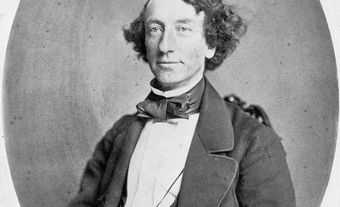Protectionism
Protectionism refers to government policies that shield domestic production (and producers) from foreign competition. For example, a Canadian tariff of 15% on an automobile that costs $5000 in a foreign country means that a tax (customs duty) of $750 will be levied on the car when it is imported to Canada. The Canadian price will be $5750, and Canadian producers of similar vehicles who can operate profitably at a price of $5750, but not $5000, will be able to compete with imports in the Canadian market. Producers dependent on protection cannot normally export, since their costs are above world prices, and they therefore depend almost entirely on the home market. (The effect of the 1965 Canada-US Automotive Products Agreement is that automobiles produced in Canada can be exported to the US, although the price in Canada is higher.)
Economic analysis shows that economic losses from a tariff exceed its benefits. Theoretically, a tariff is wasteful because it leads to a substitution of higher-cost home production for lower-cost imports; if tariffs were repealed, manpower and capital in protected industries would shift to other employments, at home or abroad, and everyone, in their role as consumers, would gain from lower prices. Owners having to change the employment of their resources would suffer losses: landowners and shareholders in the contracting industries would lose more as owners than they would gain as consumers; specialized workers in the contracting industries would probably face retraining or lower-paying jobs; and others would bear the "transitional" costs of reorganizing their economic lives. Probably the many net winners would each gain a relatively small amount, while the relatively few net losers would suffer fairly heavy losses. Nevertheless, in principle it should be possible for a government to compensate losers and still produce a net social "profit" by repealing tariffs.
The debate about protectionism has revolved around attempts to find an intellectually respectable rebuttal to the economic argument, but none has been found. Public discussion of protectionism would be better if its proponents would argue that, although it involves economic costs, these are outweighed by noneconomic benefits. The intriguing question is why virtually all governments have passed laws known to reduce their citizens' economic well-being.
Protectionist policies may confer benefits that cannot be bought in the marketplace, such as increased military security, a larger population and more diversified production, and a heightened sense of national identity. These vague contentions cannot be definitively refuted, but they seem not to fit the Canadian situation. The defence argument is largely irrelevant in countries of small populations. Belief in the virtues of size and diversification, although given no credence by economists, seems widely shared by politicians. Voters may view size and diversification as matters of national pride, in which case the "diversification" argument merges with the "national identity" argument. In Canada, arguments for protectionism are generally not supported by residents in 8 provinces who observe that the tariff diversifies production mainly in Ontario and Québec.
A second explanation may be that political dynamics almost ensure protectionist policies. Politicians are likely to support tariffs where the "protectionist" vote is concentrated, and ignore tariffs or pay lip service to "free trade" elsewhere. Even voters who would gain by repeal may vote against it in compassion for those "vested interests" whose lives would be disrupted. But this explanation is not fully satisfying. Practical techniques exist for compensating the losers from a change in government policies, so that the "compassion" argument loses force; and the "vote-getting" argument begs the question of why a political party could not promise both to raise the standard of living by phasing out tariffs and to adopt policies to ease the transition.
A third possible explanation for protectionism suggests some deep psychological or biological "imperative" compelling people to favour domestic producers and protect production in the "home territory."
Although the British North American colonies had relied upon relatively low tariffs on specific commodities for government revenues, the first coherent Canadian system of protection was established well after Confederation. Sir John A. Macdonald won the 1878 general election largely on the strength of the National Policy, a policy of Economic Nationalism designed to protect Canadian businesses against competition from lower-cost US firms. Since that time, although the 1911 general election was contested over the question of free trade with the US (see reciprocity), protectionism in some form has always been part of Canada's international economic relations.
After WWII Canada signed a General Agreement on Tariffs and Trade (GATT) that obligated member nations to reduce tariffs and other barriers to trade by multilateral negotiations. GATT has been effective in reducing tariff rates, but not in reducing "nontariff barriers." Indeed, the decline of tariffs has been accompanied by a growth of other barriers: import quotas; threats of quotas or other measures that induce foreigners to accept "voluntary export restraints" when shipping specific goods to Canada; administrative protection, by which customs officers restrict or impede the entry of imports; and many other policies ranging from exchange controls to health and safety regulations.
Canada can perhaps claim to have pioneered another form of protection: "content" provisions, which make it easier for firms to import when they produce in Canada a certain proportion of the content of the goods they sell. Content provisions have been applied to automobile firms since 1926 and are also used in the broadcasting industry.
Since WWII, several tariff substitutes have been adopted by Canadian provinces in a pronounced movement to "provincial protectionism." Marketing boards have been established to raise the incomes of certain farmers (notably milk, egg and poultry producers) by restricting provincial production, and by persuading the national government to apply tariffs to imports from abroad and "production quotas" to all provinces. Provincial governments also favour provincial producers in letting government contracts by accepting "domestic" bids even if they are higher than bids from other provinces. Recently some provinces have required firms bidding for contracts to abide by "provincial-content" rules, and some have required that particular industries give priority in hiring to applicants who reside (or perhaps were born) in the province.
The phenomenon of provincial protectionism, and the suspicion that there would also be municipal protectionism if it were feasible to restrict trade between cities - as it was in the Middle Ages when local protectionism flourished - suggests that protectionism is not simply a matter of national economic diversification or national identity.
See also Foreign Investment; Free Trade; International Trade.

 Share on Facebook
Share on Facebook Share on X
Share on X Share by Email
Share by Email Share on Google Classroom
Share on Google Classroom


